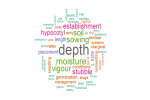Key points
- Boomerang 1 – the Antonio family’s new SwarmBot – is helping to keep weeds suppressed
- Sheep have been introduced as a risk-management tool in dry and frost-prone years and also to keep weed numbers down
- As chair of the Esperance Zone Innovation Group, Terry Antonio is keen on helping agriculture make the most of new technology by connecting innovators and promoting collaboration across agriculture
- Terry is collecting weed images for use in optical weed technologies
Spraying weeds as it trundles across the Antonio family’s farm at Salmon Gums in Western Australia’s south-eastern wheatbelt, Boomerang 1 has done almost 2500 hours and 20,000 hectares since it was brought home in September 2023.
Terry Antonio, who farms with his stepmother Alicia Antonio, says the three-metre SwarmBot, which tows a 24m spray boom, takes the strain off labour. “But the best thing is when we are busy doing other things, it can keep spraying. It has a weather station so it stops when it needs to and gets going again when it can.”
This is important in Esperance, where windy weather year-round can impede spraying operations.
With Alicia, his dad Gerard bought the property in 2006. Gerard had named it ‘Boomerang Farms’ – a nod to his return to farming and the Esperance region after many years away.
Gerard died in 2019 and since then Terry has been farming with Alicia. When the new SwarmBot needed a name, Boomerang 1 seemed apt.
Technology and Merinos
While new technology such as Boomerang 1 helps with weeds, so too does 1000 head of Merinos brought to the farm in 2022 as a risk-management tool.
Terry says his dad’s early farming career had not endeared him to sheep. “He had sheep growing up and didn’t enjoy working with them,” Terry says. “Because of that, we never had them, but a run of dry years and then frost-affected years meant we had to consider them. If things are not working well, you need to try something else.”
Today the sheep act as a buffer, helping the business ride out dry and frost-prone seasons.
We farm right out on the fringe of the cropping area and sheep give us more options to manage weeds and disease compared to a full cropping program. We can grow a pasture for two years as a break for weeds and diseases if we need to.
The sheep are kept within a 1000ha area (total property 9300ha) that is fenced and has the necessary infrastructure.
“We are building infrastructure on other parts of the property for them too. There is probably 4000ha that is now fenced and could be used if needed.”
With an annual average rainfall of 330 millimetres, Terry runs a winter cropping sequence of wheat/wheat/barley/canola or a pulse.
“We are growing more oats now too, and that can be used for hay if we need it.”
The decision on whether to plant canola or a pulse crop is rainfall-dependent. “Canola needs rain by April. If we can get it away early, it will grow well. If germination is not on time, it doesn’t perform.”
Field peas and vetch are also grown for the sheep. “Both have a nitrogen benefit and can be grazed if need be. We used to grow more field peas for grain but now we are using the vetch more often as a grazing option compared to when we used to brown manure it.
Feature: Futureproofing weed management

























































